Boxwood blight disease identified in Michigan
A serious fungal disease of boxwood that results in defoliation and decline of susceptible boxwood. A downloadable fact sheet is available.

This article is available in a printable fact sheet: Boxwood blight disease identified in Michigan.
Origin and distribution
Boxwood blight or “box blight” is a serious fungal disease of boxwood that results in defoliation and decline of susceptible boxwood. Repeated stem infections can kill young plants, and in larger plant specimens defoliation reduces the ornamental value of the plant and infection predisposes bushes to infection by other pathogens and environmental factors leading to plant death.
Boxwood blight was first reported in 1994 in the U.K. and has spread throughout an additional 12 European countries and into Asia (Georgia and Iran). It was also reported in New Zealand in 1998. In 2011, it was detected for the first time in the U.S. in Connecticut and soon after was reported in North Carolina and Virginia. Around this time, it was also reported in British Columbia, Canada.
Boxwood blight has now been reported in 28 U.S. states (AL, CA, CT, DE, FL, GA, IL, IN, KS, KY, MA, MI, MD, MO, NC, NH, NJ, NY, OH, OR, PA, RI, SC, TN, VA, WA, WI, WV), and it was detected for the first time in Michigan in 2018. In Canada, it has been reported in British Columbia, Ontario and Quebec. The prediction is that boxwood blight will continue to spread throughout boxwood growing areas of North America.
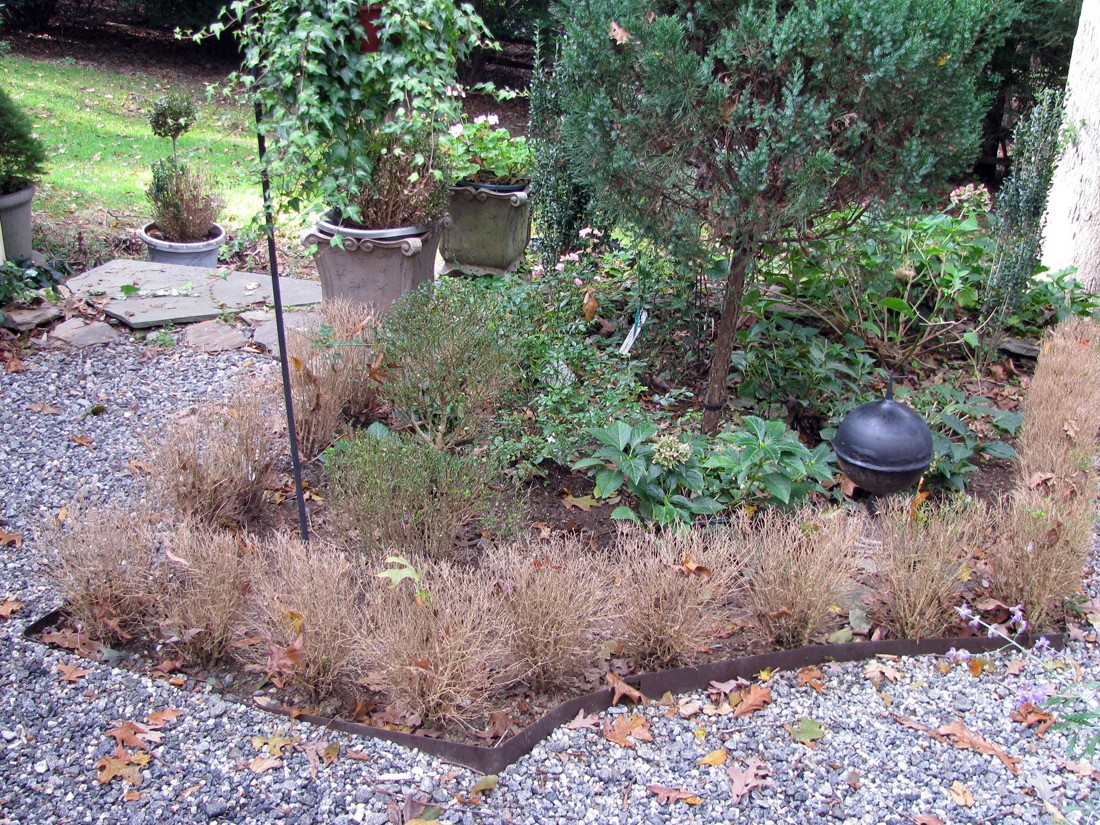
Host range
Several genera in the plant family Buxaceae are susceptible to this disease; this includes Pachysandra terminalis (Japanese spurge), Pachysandra procumbens (Allegheny spurge) and Sarcococca species (sweetbox) and of course Boxwood (Buxus species). There are 95 species of Buxus worldwide, with four species and several hybrids and 365 cultivars available in the U.S. English boxwood, Buxus sempervirens ‘suffruticosa’ and American or common boxwood, B. sempervirens, are highly susceptible to boxwood blight.
No boxwood species is known to be completely resistant to infection. Some varieties can show partial resistance, however, these partially resistant varieties can harbor the pathogen, allowing nearby susceptible varieties to become infected.
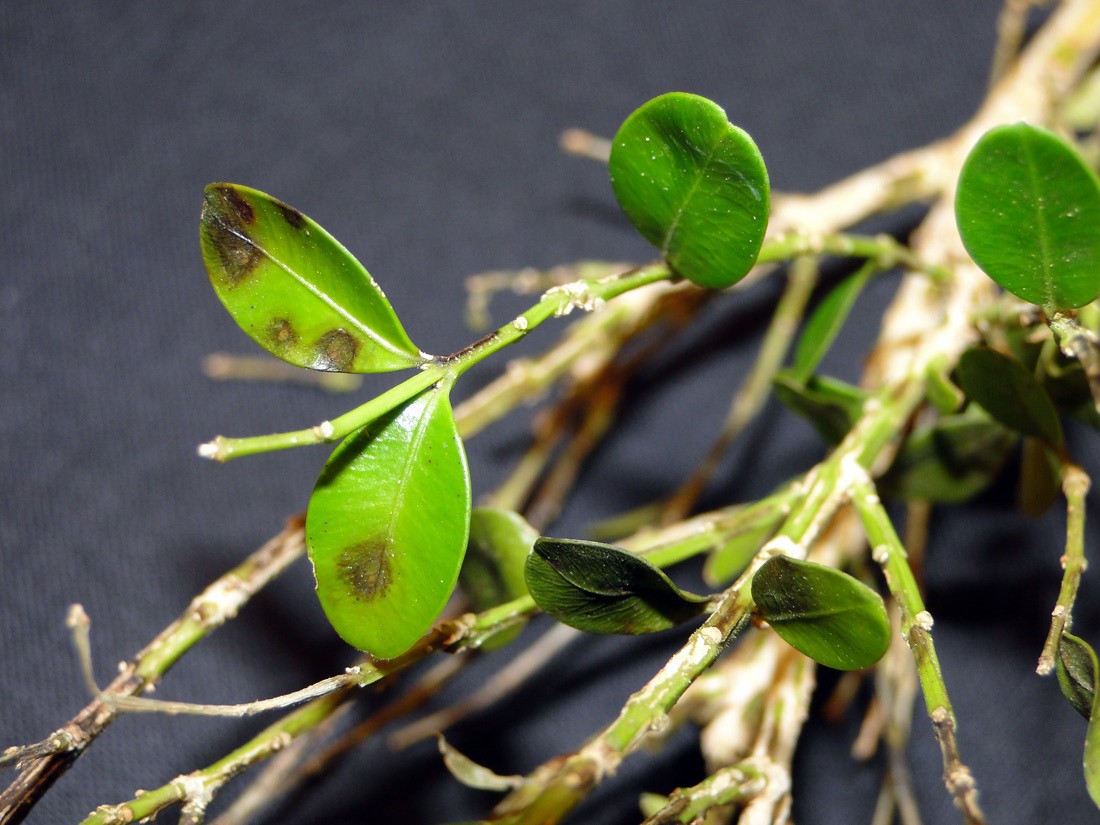
Fungus description and plant symptoms
Proper analysis by a diagnostician from a land-grant university or State Department of Agriculture is recommended because boxwood blight symptoms are similar to other boxwood diseases, insect feeding damage and abiotic disorders. It is important to note that this disease can infect boxwood at all stages of production from propagation to finished material as well as landscape plantings (Photos 1 and 2).
Often the first symptom noticed is a large amount of rapid defoliation (leaf drop), which is indicative of a severe infection. Generally, part of the plant will become chlorotic or brown, and leaves will rapidly fall to the ground, leaving bare branches behind. Initial symptoms are generally first observed in late spring or early summer when close examination of boxwood leaves may reveal round, dark or light brown leaf spots with darker borders and potentially a yellow halo (Photo 3). These spots eventually grow larger and coalesce, before turning brown or straw-like and dropping to the ground.
Black, elongated, streaking lesions may also be visible on the stem (Photos 4 and 5). These can occur on the stem from the soil line to the shoot tips. If the weather is humid, the underside of the leaf will have a white, frosty appearance caused by the formation of upright bundles of fungal spores.
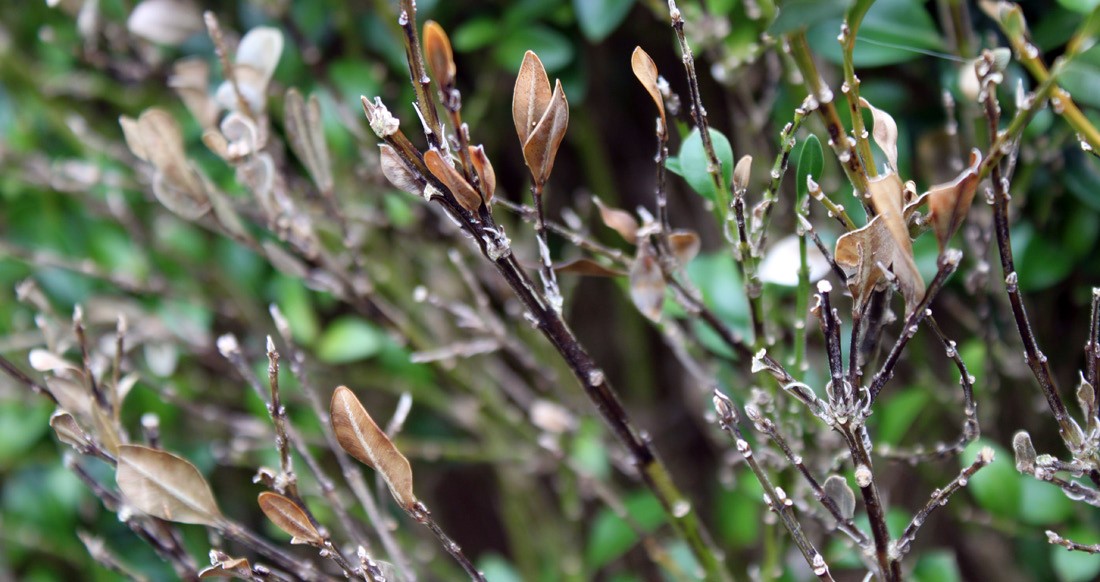
How is it spread?
The fungus that causes boxwood blight produces sticky spores. These spores can attach to animals (birds, deer or people), plant material, tools, equipment, shipping containers and vehicles. The major means of spread of this pathogen is by movement of contaminated plant material (e.g., fallen, infected leaves, container or field-grown boxwood, boxwood greenery used for holiday decoration), but boxwood blight spores can also be spread on pruning tools, clothing, equipment and anything that might have contacted infected plants. The spores may be moved over short distances (between plants, within hoop houses or within a field) by wind-driven rain or splashing irrigation water.
Long-distance spread of this disease occurs via movement of infected plants or plant debris, or from infested soil or equipment. The resting spore structures (microsclerotium) that the pathogen produces ensures the pathogen can persist in plant debris on the soil surface or buried below the soil surface for up to five years.
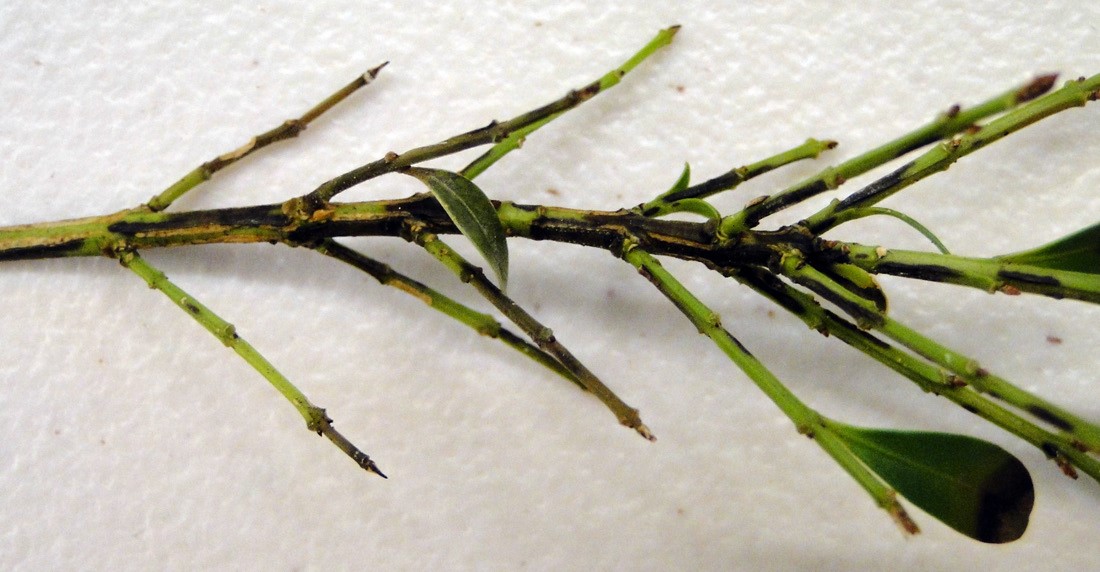
Life cycle
This pathogen can complete a life cycle in one week under warm and humid conditions. Fungal growth occurs in a broad temperature range from 41 to 86 degrees Fahrenheit with the optimum temperature for reproduction at 77 F.
Like many fungal diseases, moisture is necessary for infection. Free water from dew, irrigation and rain play a part in the severity of the disease and is an element to carefully monitor. This fungus does not need a wound to infect the plants; it can readily penetrate the cuticle and epidermis. It produces spores in clumps that can be seen on the undersides of infected leaves and on the black lesions on stems (Photo 6). The fungus survives in leaves and cankers as well as in leaf debris that has been infected.
The boxwood blight pathogen can persist for long periods of time because of specialized structures called microsclerotia that are present on fallen leaves. The overwintering fungus will produce spores that are capable of infecting host plants under appropriate environmental conditions.
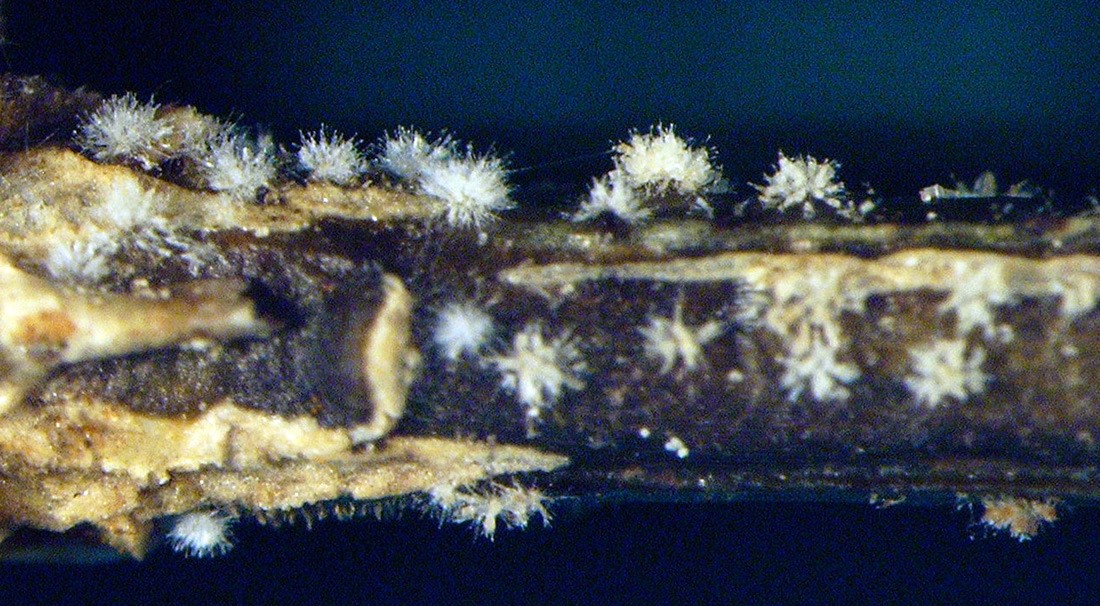
Integrated pest management (IPM) strategies
The best methods for Michigan nurseries to minimize the risk of boxwood blight introductions include purchasing plants from nurseries that participate in the “Boxwood Blight Cleanliness Program,” carefully inspecting incoming plants and potentially quarantining incoming plants (as fungicides can mask symptoms) for four weeks. Remember, even resistant varieties can harbor a “cryptic infection” (not visible), so make sure your plants come from a reputable source.
However, if an incursion does occur, there are integrated management options that can be used to prevent or limit the spread and reduce the impact it can have in Michigan. This includes preventing further introductions, sanitation, scouting, chemical control and using resistant cultivars.
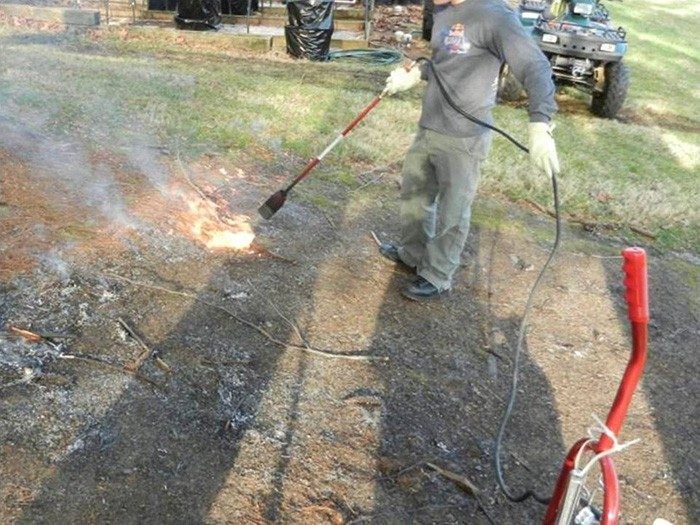
Scouting the crop for the disease is a critical step in managing boxwood blight. Both boxwood and Pachysandra should be regularly scouted for signs of disease. In greenhouses, temperature and moisture management can reduce the infection potential and disease spread. In nurseries, proper water management can reduce disease spread. Using drip irrigation systems eliminates the splashing of water from an overhead irrigation system.
If boxwood blight is confirmed, it is critical to remove all infected material (whole plants, fallen debris) and either double bag and dispose/bury or burn (Photo 7). Fungicide trials have been performed in several states and efficacy data on various fungicides is available. Michigan State University Extension educators can assist growers and homeowners with fungicide recommendations.
Download the printable, PDF version of this fact sheet: Boxwood blight disease identified in Michigan



 Print
Print Email
Email

